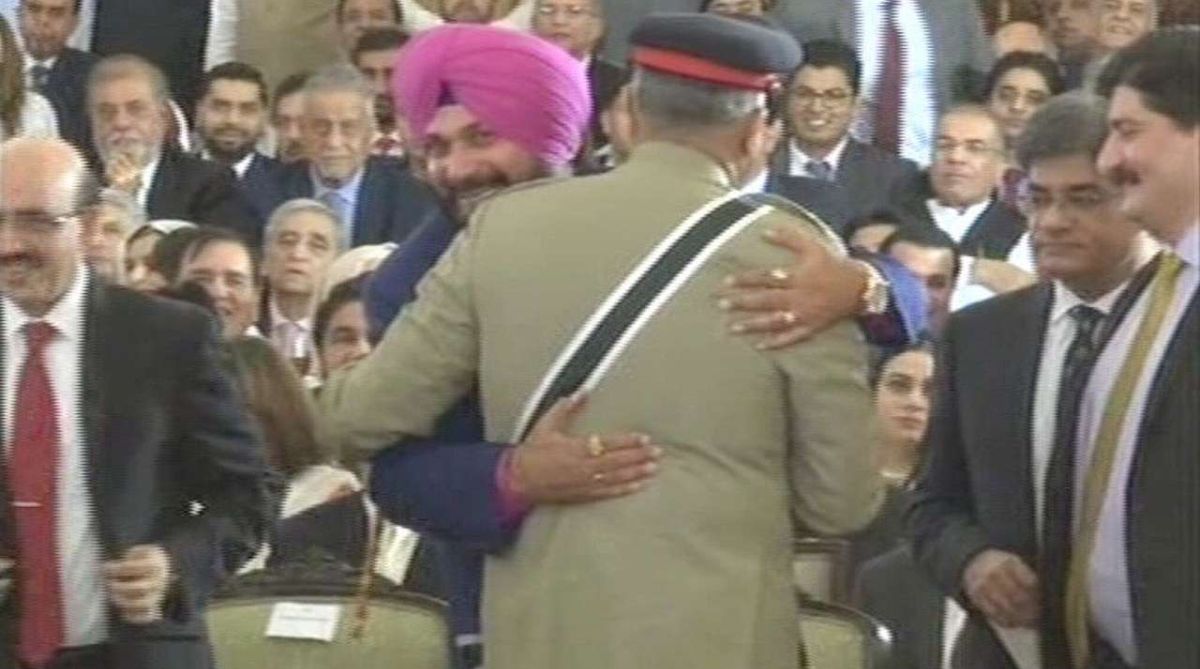Amit Shah says BJP will remove Muslim reservation
Shah was in Telangana to address a public rally at Siddipet for the party candidate for Medak Lok Sabha constituency, M Raghunandan Rao.

(Photo: Screengrab)
The knives are out for Navjot Singh Sidhu in India for hugging Pakistan’s army chief General Qamar Javed Bajwa. But in Pakistan, he is a hero. The day after the controversial hug, Pakistani newspapers splashed the photograph of the duo on their front pages with rah-rah write-ups. “Pakistan loves Sidhu’s jadoo ki jappi,” swooned one newspaper headline.
Actually, Sidhu is in double trouble. He hugged Bajwa not once, but twice. The story behind the hugs is interesting. It turns out Bajwa wanted to be a cricketer when he was young. Instead, he joined the army and cricket remains an unfulfilled dream.
Apparently, he was keen to meet Sidhu because of the cricket connection, which is why the visiting cricketer-turned-politician was seated in the front row at Imran Khan’s swearing-in ceremony.
Advertisement
The optics were terrible because next to him was the “president” of POK Masood Khan. It seems Sidhu didn’t even know who he is and so when he was shown his seat, he simply sat down.
Bajwa came up to greet him and chatted about his unfulfilled youthful ambition to be a cricketer. But what turned Sidhu emotional and made him throw caution to the winds was the army chief ’s promise that Pakistan would open a corridor to Gurdwara Darbar Sahib in Kartarpur next year for Sikh pilgrims from India to visit on Guru Nanak’s 550th birth anniversary.
The Gurdwara is believed to mark Guru Nanak’s final resting place and Sikh groups have been pleading with the Modi government for the past couple of years to request Pakistan to allow pilgrims to pay homage at the shrine in 2019.
While ultra-nationalists are slamming the former cricketer for “sedition”, the Sikh in Sidhu must have been overjoyed by Bajwa’s assurance and what better way to express his gratitude than to give the army chief a bear hug or as Sidhu prefers to call it, a “jadoo ki jappi’’. Bajwa too seems to have been overcome by the jadoo because he went on to say that Pakistan will think of doing even better things. Sidhu gave him another hug.
Later, as news filtered in from India that he was being criticised and abused, Sidhu conjured up one of his famous two-line rhymes to say that he doesn’t care what people say about him.
Doing a Nehru
The BJP is doing a Nehru with Vajpayee’s ashes. Only, instead of simply scattering the ashes across the country from a plane, as was done with Nehru’s remains, the party has decided to immerse them in 100 rivers.
It’s a gigantic operation and the result is often hilarious as we’ve been seeing in videos that have gone viral. Somewhere the boat carrying BJP leaders capsized in a river, somewhere else BJP leaders were seen doing hi-fives and guffawing.
It seems this was Amit Shah’s idea. He wanted to give a bigger and grander tribute to Vajpayee than the Congress gave to Nehru but he clearly cannot control the shenanigans of his party leaders.
Nehru had written in his will what he wanted done with his ashes. He asked for a small urn to be immersed at the confluence of the Ganges and Yamuna in Allahabad and the rest to be scattered from an airplane over the fields of India.
Indira Gandhi’s ashes were also scattered, but over the snowcapped peaks of the Himalayas which she loved so much. This was a decision taken by her son, Rajiv.
In Vajpayee’s case, Amit Shah is taking the decisions. He seems more interested in making a political statement by setting a record.
The journey of Vajpayee’s ashes began at the traditional immersion spot in Haridwar. It continued to Lucknow, Gwalior and Vajpayee’s ancestral village in Bateshwar near Agra. His grandfather had migrated from here to Gwalior where Vajpayee grew up.
Cricket revamp
One of Imran Khan’s big election promises was to overhaul Pakistani cricket and revive its glory days. So it was hardly surprising that one of his first moves after being sworn in as prime minister was to appoint a new chief for Pakistan Cricket Board, former ICC president Ehsan Mani.
In fact, he had hinted at “massive changes’’ in Pakistan cricket after his oath taking ceremony. He was speaking to former cricketers including members of the triumphant 1992 World Cup winning squad.
Imran Khan never made any secret of his dislike for Mani’s predecessor Najam Sethi who was appointed to head PCB by former prime minister Nawaz Sharif. On more than one occasion, Khan publicly stated that Sethi did not have the qualifications to head a cricket board.
In return, Sethi mocked him regularly in his satirical column in the newspaper he edited, The Friday Times. The column, titled “Im the Dim’’, is written in a diary format and Sethi has hit Imran Khan hard on many occasions.
Although his term was officially due to end in 2020, Sethi must have read the writing on the wall and stepped down before he was sacked. Actually, Pakistan has a tradition of changing PCB chiefs with every change in government. Ten years ago, Nasim Ashraf quit as PCB president hours after the then President General Musharraf announced his resignation. Ashraf was handpicked for the job by Musharraf.
When Benazir Bhutto’s husband Asif Ali Zardari became PM, he picked close friend Chaudhry Zaka Ashraf for the job. Nasim Ashraf took over when Nawaz Sharif was elected PM.
The buzz in Pakistan is that Imran Khan has two major challenges on his hands. One is to restore a semblance of normalcy in India-Pak ties and the other is to revive Pakistan cricket which has been floundering in a sea of allegations of match fixing and other corruption. Let’s see what someone who is a former cricket hero on both sides of the border can do.
Advertisement